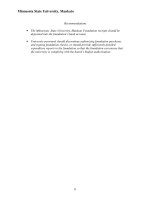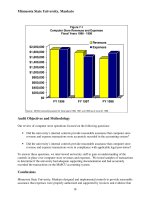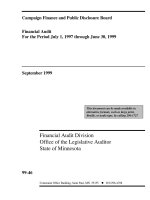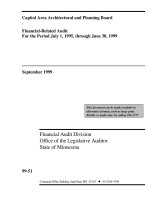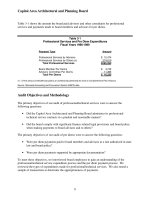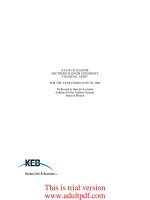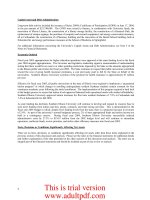Minnesota State University, Mankato Financial Audit For the Period July 1, 1995 through June 30, 1998_part1 pdf
Bạn đang xem bản rút gọn của tài liệu. Xem và tải ngay bản đầy đủ của tài liệu tại đây (214.98 KB, 10 trang )
Minnesota State University, Mankato
Financial Audit
For the Period July 1, 1995 through June 30, 1998
August 1999
Financial Audit Division
Office of the Legislative Auditor
State of Minnesota
99-45
Centennial Office Building, Saint Paul, MN 55155 651/296-4708
This document can be made available in
alternative formats, such as large print,
Braille, or audio tape, by calling 296-1727
SUMMARY
State of Minnesota
Office of the Legislative Auditor
1st Floor Centennial Building
658 Cedar Street • St. Paul, MN 55155
(651)296-1727 • FAX (651)296-4712
TDD Relay: 1-800-627-3529
email:
URL:
Minnesota State University, Mankato
Financial Audit
For the Period July 1, 1995, through June 30, 1998
Public Release Date: August 26, 1999 No.99-45
Background
Minnesota State University, Mankato was established in 1866. The university offers
undergraduate and graduate students more than 150 programs of study. The largest programs
include elementary education, computer science, nursing, law enforcement, and accounting.
Dr. Richard Rush became the president of Minnesota State University, Mankato in 1992. The
university changed its name from Mankato State University to Minnesota State University,
Mankato on September 18, 1998.
Our audit scope covered the period from July 1, 1995, through June 30, 1998. We audited
general financial management; tuition, fees, and room and board; employee and student payroll;
operating expenditures; computer store operations; and other revenue. We also reviewed the
university's internal controls over compliance with federal student financial aid for fiscal year
1999.
Conclusions
We found that Minnesota State University, Mankato properly recorded its financial activities on
the MnSCU and MAPS accounting systems with a few exceptions, and that the university
operated within its financial resources. We found that the university did not record some
transactions correctly on the accounting system. We determined that the university had good
internal controls overall. However, the university did not limit computer access to MnSCU
accounting and payroll/personnel systems for university and system office employees. We also
found that the university needs to improve controls over computer store operations. In addition,
the university needs to clarify its relationship with the Minnesota State University, Mankato
Foundation.
For student financial aid, we concluded that Minnesota State University, Mankato designed and
implemented internal controls to provide reasonable assurance that it managed state and federal
student financial aid programs in compliance with specific program requirements in fiscal year
1999. The university complied with federal student financial aid requirements over cash
management and federal reporting for the items tested.
In its written response to the audit report, the university stated that although they did not agree
with all the findings and recommendations, they will apply them in an effort to enhance their
business, accounting, and financial affairs. We believe the university’s plans will adequately
address the issues in the audit report.
STATE OF MINNESOTA
OFFICE OF THE LEGISLATIVE AUDITOR
JAMES R. NOBLES, LEGISLATIVE AUDITOR
Representative Dan McElroy, Chair
Legislative Audit Commission
Members of the Legislative Audit Commission
Mr. Morrie J. Anderson, Chancellor
Minnesota State Colleges and Universities
Members of the Minnesota State Colleges and Universities Board of Trustees
Dr. Richard Rush, President
Minnesota State University, Mankato
We have audited selected areas of Minnesota State University, Mankato for the period July 1,
1995, through June 30, 1998, as further explained in Chapter 1. Our audit scope included the
following areas: general financial management; tuition, fees, and room and board; employee and
student payroll; operating expenditures; computer store operations; and other revenue. We also
reviewed the university's internal controls over compliance with federal student financial aid for
fiscal year 1999.
We conducted our audit in accordance with generally accepted auditing standards and
Government Auditing Standards, as issued by the Comptroller General of the United States.
Those standards require that we obtain an understanding of management controls relevant to the
audit. The standards require that we design the audit to provide reasonable assurance that
Minnesota State University, Mankato complied with provisions of laws, regulations, contracts,
and grants that are significant to the audit. Management of the university is responsible for
establishing and maintaining the internal control structure and complying with applicable laws,
regulations, contracts, and grants.
This report is intended for the information of the Legislative Audit Commission and the
management of Minnesota State University, Mankato. This restriction is not intended to limit the
distribution of this report, which was released as a public document on August 26, 1999.
James R. Nobles Claudia J. Gudvangen, CPA
Legislative Auditor Deputy Legislative Auditor
End of Fieldwork: May 21, 1999
Report Signed On: August 23, 1999
1ST FLOOR SOUTH, CENTENNIAL BUILDING 658 CEDAR STREET ST. PAUL, MN 55155
TELEPHONE 651/296-4708 TDD RELAY 651/297-5353 FAX 651/296-4712 WEB SITE
Minnesota State University, Mankato
1
Chapter 1. Introduction
Minnesota State University, Mankato was established in 1866. The university offers
undergraduate and graduate students more than 150 programs of study. The largest programs
include elementary education, computer science, nursing, law enforcement, and accounting.
During fiscal year 1998, Minnesota State University, Mankato had an enrollment of 11,681.
Dr. Richard Rush became the president of Minnesota State University, Mankato in 1992. On
September 18, 1998, the university changed its name from Mankato State University to
Minnesota State University, Mankato.
Minnesota State University, Mankato is affiliated with the Minnesota State University, Mankato
Foundation. The foundation promotes, accepts, and manages private gifts to the university. The
foundation functions primarily to provide student scholarships, capital acquisitions for the
university, and enrichment opportunities for the faculty.
Minnesota State University, Mankato finances its operations primarily from state appropriations
and student tuition and fees. The MnSCU system office allocates a portion of the system-wide
appropriation to the individual colleges and universities based on a formula. Table 1-1 provides
a summary of the university's sources and uses of funds reported in the General Fund, Special
Revenue Funds, Enterprise Funds, and Capital Projects Fund for the fiscal year ended June 30,
1998.
Minnesota State University, Mankato
2
Table 1-1 (a)
Sources and Uses of Funds
Fiscal Year Ended June 30, 1998
General
Fund
Special
Revenue Funds
Enterprise
Funds
Capital
Projects Fund
July 1, 1997, Fund Balance $ 5,767,022 $ 718,423 $10,333,333 $ 0
Sources:
State Appropriation $43,071,769 $ 0 $ 1,475,627 $3,474,010
Tuition and fees 29,889,280 2,231,794 2,209,959 0
Rent/Sales 855,037 1,414,917 12,275,023 0
Investment Income 0 58,395 298,556 0
Student Financial Aid 0 0 318,169 0
Federal Grants 0 6,379,119 41,211 0
State Grants 485,071 58,196 13,737 0
Private Grants 25,816 105,152 246,666 0
Non-mandatory Transfers In 95,475 940,569 303,388 0
Other 3,036,505 60,550 465,652 0
Subtotal Sources $77,458,953 $11,248,692 $17,647,988 $3,474,010
0
Total Sources $83,225,975 $11,967,115 $27,981,321 $3,474,010
Uses:
Salary and Fringe $58,858,741 $2,861,958 $3,983,840 $0
Purchased Services 6,430,951 1,399,867 6,284,742 1,887,627
Utilities 1,771,037 0 744,777 0
Supplies 4,089,364 734,605 1,563,987 29,665
Supplies for Resale 0 0 1,836,395 0
Equipment 2,039,545 51,641 26,221 0
Debt Service 660,746 0 2,035,578 0
Buildings – Lease 54,384 0 0 507,101
Financial Aid 644,114 5,231,157 227,882 0
Indirect Costs 96,624 223,283 10,035 0
Non-mandatory Transfers Out 134,473 256,455 900,184 0
Other 556,587 162,136 297,586 0
Total Uses $75,336,566 $10,921,102 $17,911,227 $2,424,393
June 30, 1998, Fund Balance $ 7,889,409 $ 1,046,013 $10,070,094 $1,049,617
(a) Table 1-1 does not include all funds, such as the Agency Funds and Endowment Funds.
Note: Table 1-1 is prepared on the budgetary basis of accounting. This basis does not include long-term assets and liabilities.
Examples of financial activity not included in the table are tuition receivables not collected as of the close of books and
compensated absence liabilities. The university's June 30, 1998, compensated absence liability was estimated to be
about $7.6 million. Also, the unrecorded liability for 1998 contract increases paid to faculty and administrators for
contracts settled during fiscal year 1999 are estimated at $1.2 million. The fiscal year 1998 General Fund unrestricted
reserve was $3,205,388.
Source: Based on the summary data prepared by the university from the MnSCU accounting system as of April 12, 1999.
Minnesota State University, Mankato
3
Chapter 2. Financial Management
Chapter Conclusions
Minnesota State University, Mankato’s internal controls provided reasonable
assurance that it operated within its available resources. The university had an
effective process to monitor its revenue and expenditure budgets. The
university properly accounted for and controlled its local bank accounts and
completed bank reconciliations timely. With the following exceptions, the
university properly recorded all of its state treasury and local account activity
on the MnSCU and MAPS accounting systems. The university did not properly
record some expenditure transactions that could impact financial reporting.
We also noted that the university did not adequately restrict computer access for
some employees. In addition, we concluded that the university needs to clarify
its relationship with the Mankato State University Foundation.
Minnesota State Colleges and Universities (MnSCU) receives the majority of its funding for
operations from General Fund appropriations. The MnSCU system office allocates appropriated
funds to Minnesota State University, Mankato and other colleges and universities based on an
allocation formula. In addition, Minnesota State University, Mankato retains the tuition and
other receipts it collects to arrive at its total authorized spending level.
On July 1, 1995, MnSCU began operations. At that time, a new computerized accounting
system, MnSCU accounting, as well as the State Colleges and Universities Personnel/Payroll
System (SCUPPS) emerged. MnSCU required all campuses to use the MnSCU accounting
system to account for both money maintained within the state treasury and local activity accounts
maintained outside the state treasury.
The State of Minnesota also implemented a new computerized accounting system (MAPS) and a
new personnel/payroll system (SEMA4) that began operations on July 1, 1995. The state's
accounting system (MAPS) is the primary accounting system for funds appropriated to state
agencies. MnSCU campuses used the MnSCU accounting system to initiate transactions that
involved appropriated funds. Through a system interface, the MnSCU accounting system
recorded summary transactions on MAPS. MAPS then generated state treasury warrants for
state-appropriated expenses.
Minnesota State University, Mankato is affiliated with the Minnesota State University, Mankato
Foundation, a non-profit organization. The university provided administrative support to the
foundation. Foundation financial statements are prepared annually and subjected to an external
audit by a CPA firm. According to its audited financial statements, the Mankato State University
Foundation had total revenues of $11.7 million and total expenses of $2.3 million in fiscal year
1998. As of June 30, 1998, the foundation had an ending fund balance of approximately $21
million.
Minnesota State University, Mankato
4
Audit Objectives and Methodology
Our review of Minnesota State University, Mankato's overall financial management focused on
the following questions:
• Did the university’s internal controls provide reasonable assurance that it operated within
available financial resources?
• Did the university’s internal controls provide reasonable assurance that state treasury and
local bank financial activities were adequately safeguarded, accurately recorded in the
accounting records, and in compliance with applicable legal provisions and
management's authorization?
• Did the university establish an appropriate relationship with its foundation?
To answer these questions, we interviewed university staff to gain an understanding of the
MnSCU accounting system as it pertained to each of the individual program areas included in
our audit scope. We gained an understanding of management controls in place over the local
bank accounts. We reviewed MnSCU transactions posted to the accounting records to determine
if the university properly recorded revenue and expenditure transactions in MnSCU accounting
for both state treasury and local activities. In addition, we discussed the university's budgetary
process with university administrators. We also reviewed computer security privileges to
determine whether the university had adequately restricted access to its computerized business
systems. Finally, we reviewed the university’s contract with the Mankato State University
Foundation and copies of the foundation’s financial statements.
Conclusions
Minnesota State University, Mankato operated within its available resources. The university
properly recorded all of its state treasury and local bank account activity on the MnSCU and
MAPS accounting systems, except that the university did not properly record some financial
transactions, as discussed in Finding 1.
The university properly accounted for and controlled its local bank accounts and completed bank
reconciliations timely. However, we found that the university did not adequately restrict
computer access for some employees, as discussed in Finding 2. In addition, we determined that
the university needs to clarify its operating relationship with its foundation. We discuss this
issue in Finding 3.
1. Minnesota State University, Mankato did not properly record some financial
transactions.
Minnesota State University, Mankato improperly recorded some expenditure transactions in the
MnSCU accounting system, potentially impacting financial statement presentation. The issues
involved the use of occurrence dates for computer store expenditures and the recording of a
capital improvement.
Minnesota State University, Mankato
5
The university did not use the correct occurrence dates for computer store expenditures. We
found that eight of ten computer store expenditures tested had incorrect occurrence dates.
Incorrect occurrence dates may cause the financial statement for accrued liabilities at year-end to
be misstated. Computer store staff send copies of the receiving logs with the dates the goods
were received to the business office. However, business office staff did not always record the
date the items were received as the occurrence date in the accounting system. Some of the
occurrence dates recorded were the invoice date or the date that the business office received the
invoice. We also found times when the business office paid several invoices at one time,
recording only one occurrence date for several purchases. Computer store expenditures for fiscal
year 1998 totaled $1,757,516.
In addition, the university incorrectly recorded a capital improvement as a repair. The university
made a payment of $369,532 for a chiller plant expansion and recorded it on the accounting
system as a repair. The improvement should have been capitalized and recorded as a betterment
to buildings. The error occurred because of similar object code descriptions in MnSCU
accounting for repairs and for betterments.
Recommendations
• The university should ensure that the occurrence date on the accounting
system for year end computer store expenditures is the date that the goods
were received or services were provided.
• The university should record capital improvements as betterments to
buildings.
2. Minnesota State University, Mankato did not adequately restrict certain employee
computer system access privileges.
Minnesota State University, Mankato did not adequately monitor or control access to its
computerized business systems. Those systems included the MnSCU accounting system, the
personnel/payroll system, and the Unisys system.
Within the MnSCU accounting system, four purchasing department staff and one business office
staff had inappropriate access to encumber funds, generate purchase orders, and enter payments.
This created incompatible privileges, which increased the likelihood that an improper transaction
could occur and go undetected. University management feels that the budgetary controls are
adequate to detect any errors or irregularities. We believe, however, that with the high volume
of expenditure transactions that it would be more effective to address the incompatible duties by
restricting access to the computer system rather than rely on detecting unauthorized transactions
that could occur. Alternatively, the university could generate a transaction report from the
accounting system that would list the transactions processed by these employees. Management
could periodically review the report to ensure the propriety of the activity. In addition, one
employee transferred from the business office to the human resources department about two
years ago, yet still had access rights to encumber funds and process disbursements. Also, a
student assistant no longer working in the payroll department still had access to update the
university’s personnel and payroll information through SCUPPS.
Minnesota State University, Mankato
6
We also found that five MnSCU system office employees and a student assistant no longer
working in the payroll department had access to update Minnesota State University, Mankato
personnel and payroll information through SCUPPS. These employees could add personnel,
change assignments, issue lump-sum payments, and adjust salary information for university
personnel. None of the MnSCU system office employees performed any of these functions for
the university; the university’s human resource office handled all such transactions.
During our review of Unisys access, we also noted that employees who regularly handled cash
and checks, resulting from parking fines, also had access to reduce or eliminate charges on the
system. This presented a control weakness because these individuals could potentially receive
cash or a check payment for a charge, delete the charge from the Unisys system, and
misappropriate the payment. The business office did not appear to have any mitigating controls
to detect such activity. However, MnSCU has recently developed one information system to
replace the Unisys system. Minnesota State University, Mankato has begun to use the new
system to record information for fiscal year 2000 and is discontinuing its use of the Unisys
system.
Recommendation
• Minnesota State University, Mankato should improve security access controls
by:
either restricting access to MnSCU accounting based upon job
responsibilities to ensure an adequate separation of duties that would
prevent unauthorized transactions from occurring, or developing and
reviewing management reports to ensure the propriety of the expenditure
transactions;
removing SCUPPS computer access by MnSCU system office staff; and
periodically reviewing system user security reports and modifying any
inappropriate system access privileges.
3. Minnesota State University, Mankato needs to clarify the operating relationship with its
foundation.
Minnesota State University, Mankato has an unclear relationship with the Minnesota State
Univeristy, Mankato Foundation. The foundation’s independence is blurred by the university’s
oversight of foundation operations. Our review of the foundation disclosed that the university
deposits foundation receipts into the university’s bank account. We also found that university
employees have the authority to approve foundation purchases and sign checks from the
foundation bank account. The university has a contract with the foundation that specifies the
rights and responsibilities of both organizations. The university employs a vice president of
university advancement who is the university’s authorized agent to oversee the administrative
support for the foundation. The foundation had total revenues of $11.7 million during fiscal year
1998.
Minnesota State University, Mankato
7
Minnesota State University, Mankato deposits foundation receipts directly into the university’s
bank account. The university then transfers foundation receipts into the foundation’s bank
account. As a separate legal entity, the foundation is a private, tax exempt, nonprofit
organization created solely for the purpose of raising funds to maintain and enhance university
programs and operations. The university believes it is more efficient to process one combined
deposit for the university and the foundation. Personnel also told us that occasionally both the
foundation and the university are named as payees per the check. We believe, however, that
checks made payable to the foundation should be deposited in the foundation’s bank account to
maintain the legal distinction between the two entities. The contract between the university and
the foundation also specifies that separate bank accounts will be maintained.
University employees approve purchases and sign all checks under $2,500 written from the
foundation’s bank account based on an operating budget that is authorized by the foundation
board. Foundation policy states that the dean of the college or the vice president/director of the
unit receiving foundation funds has the responsibility to administer the account and disburse the
funds. Two signatures are required for any checks written from the foundation’s bank account.
Authorized signatures include the following university employees: the vice president of finance
and administration, the comptroller, the accounting director, and the foundation accountant. The
foundation treasurer must approve all checks over $2,500. The foundation receives a quarterly
budget report from the foundation accountant. However, the report does not provide information
on individual transactions. We believe the expenditure of funds is a managerial responsibility
that should rest with the foundation. The contract with the foundation authorizes university
employees to perform administrative functions, but not to perform managerial responsibilities.

